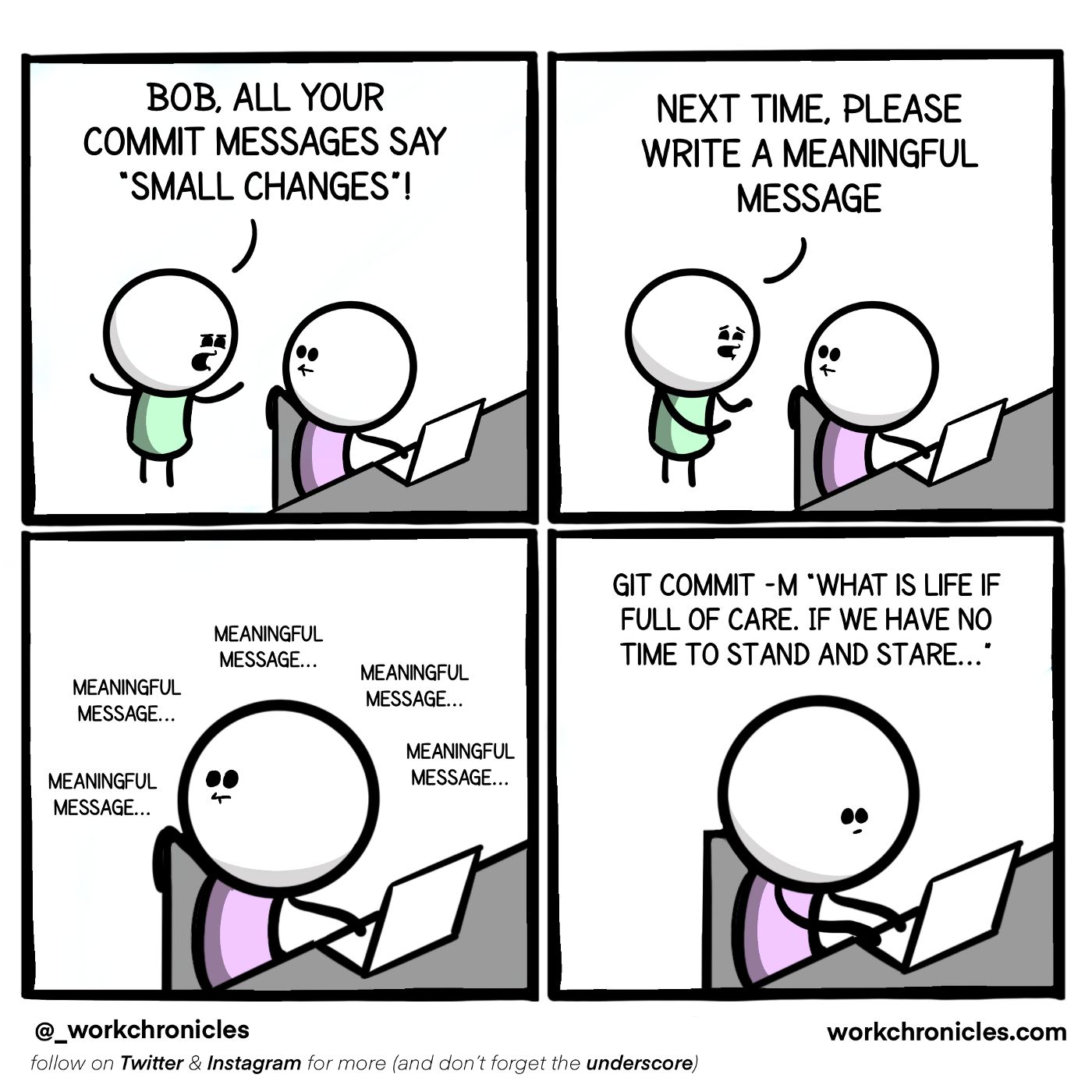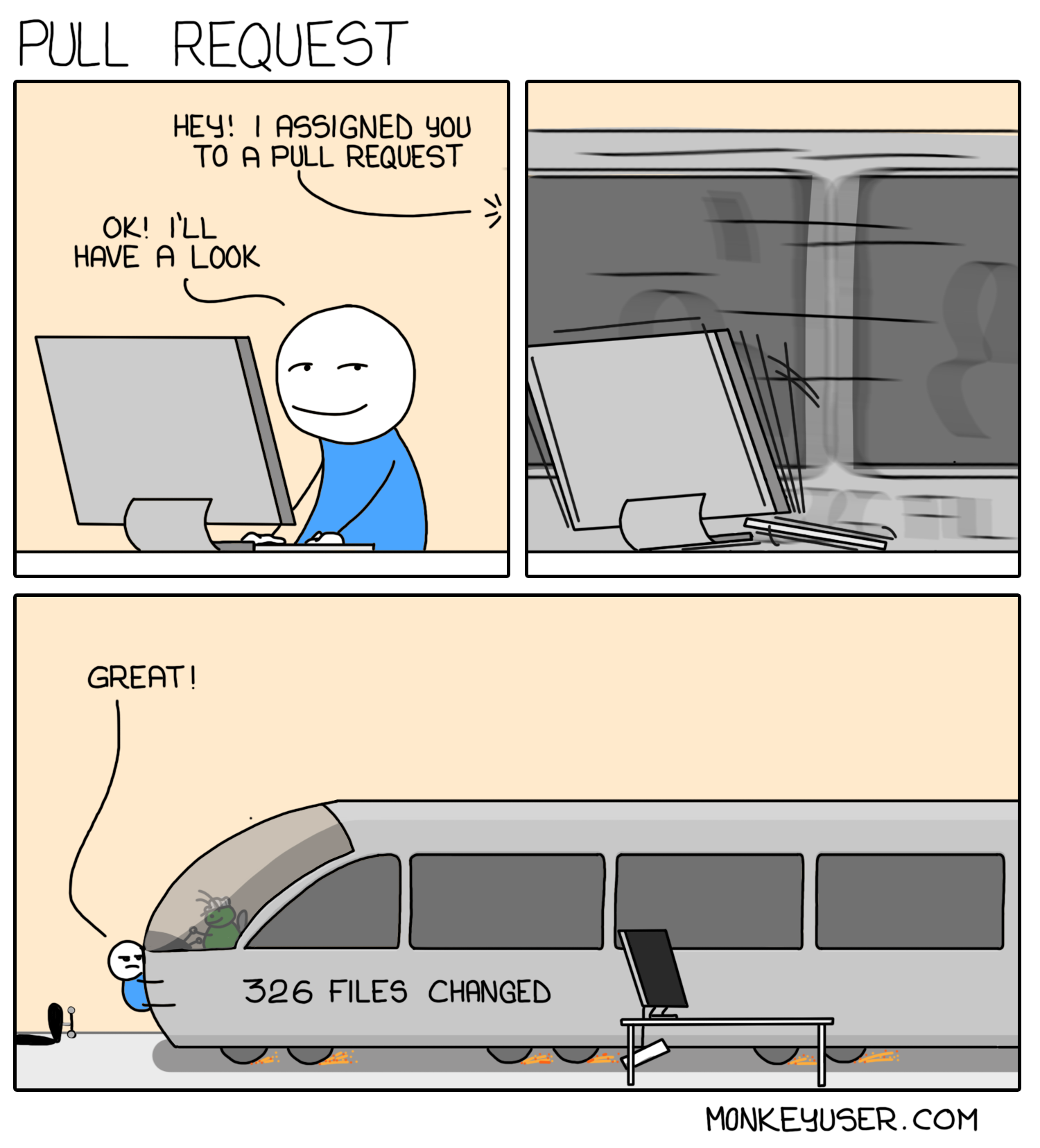PR Preparation
Step 1: Stage your changes
# Shorter
git add -p
# Or even shorter with an alias
git config --global alias.adp 'add -p'
git add –patch
Interactively choose hunks of patch between the index and the work tree and add them to the index. This gives the user a chance to review the difference before adding modified contents to the index.
Note that this will not add new files, you still have to add those with a git add new_file!
For each hunk you have a few options, the most common:
| Key |
Meaning |
| y/n |
Add or don’t add the hunk |
| a/d |
Add all hunks in the file or skip to the next file |
| s |
Split the hunk into smaller ones |
| e |
Decide manually on a line-per-line basis |
| q |
Quit. Whenever it turns out there is still some work left! |
Step 2: Review the staging area
Before doing the actual commit, go over all staged changes: are you about to commit everything that is needed, and nothing more?
git diff --staged
# With an alias of course!
git config --global alias.dfc 'diff --staged'
Step 3: Commit!

Don’t write your life’s story (at least not in a commit message!) but do add something meaningful, what exactly are you changing? Are you fixing a bug, improving performance, doing source-code cleanup, a refactoring or are you implementing a new feature?
I always try to get the entire team onboard for starting each commit message with a ticket ID so that there is always a link back to your bug tracking system or Scrum board. These artifacts are typically long-lived and may contain additional information like a link to the analysis, comments from team members, file attachments etc!
Step 4: Create the PR
You obviously also want to automate this! See our blog post on exotic git snippets for a small script to create a PR like a breeze.
# Creating a PR from the commandline:
pr
Check the “Files changed”
Since a PR typically exists of multiple commits, before sending the PR to your colleague, make sure to go through all your changes one last time.
Consider a PR checklist
Most systems allow you to create a file like .github/pull_request_template.md where you can add a checklist of things that are recurring comments from reviewer(s) that could’ve been easily catched by the PR creator.
Poor Hygiene Examples
Lingering debug statements
The PR still contains statements that a quick glance would’ve catched:
console.log('val', someValue);
debugger;
// TODO: xyz
You made some changes to speed up your manual testing, that is OK but make sure you don’t commit this!!
function isLoggedIn() {
// return !!this.userService.token;
return true;
}
Should never have been committed
Earlier this week I deleted an HTML file which contained local test run results.
Typically everything that is generated should not be committed as it can just be re-generated on the fly!
There are exceptions, for example a package-lock.json is generated but is used by a CI/CD pipeline to make sure new npm installs the exact same thing.
Deleting such files is not enough though, create a PR to add the file/folder to your .gitignore so that this can never happen again!
When in doubt whether you should .gitignore something, google it!
Avoid Superfluous Changes
These are changes that typically happen automatically on a save and means that someone has a different linter installed, or that they are running their linter with different settings 😲
- constructor(private socksService: SocksService) {}
+ constructor(private socksService: SocksService) { }
Another classic, with one keystroke you can add missing imports but of course your default IDE configuration is different from the style that is used in 99% of the rest of the code base.
Fix your configuration or fix the styling, please!
import { Review } from './sock.model';
+import {TimeAgoPipe} from '../time-ago.pipe';
It’s cool to have an .editorconfig but if not all devs have the plugin installed in their IDE, it is pretty useless:
-}
+}
No newline at end of file
Same for some extra whitespace at the end of a line: <router-outlet /> vs <router-outlet /> . Please don’t 🥺
Note that a git hook, for example with Husky, can pretty much solve this in your team by automatically fixing all linting issues right before a commit.
Not Needed After All
If your first hunk is this one and there are no others in the same file, I guess you moved the code to somewhere else and forgot to clean up your import statements!
+import { LOCALE_ID } from '@angular/core';
You added a new package but didn’t end up actually using it or ended up using another one? Remove the dependency!
"dependencies": {
+ "cool-package-i-did-not-use-in-the-end": "1.0.0",
+ "@types/cool-package-i-did-not-use-in-the-end": "1.0.0",
}
Also note that dev stuff should be in devDependencies!
Local Configuration
Manual or automatic changes for local dev configuration should never be checked in! That db connectionString on your local machine has no place being in the official repo. Check our blog post on Git Skip Worktree how you can make it easier to avoid this.
You are also opening up your project for a merge conflict on pretty much every PR until eternity…
// PR from colleague A
"cli": { "analytics": false }
// PR from colleague B
"cli": { "analytics": "guid" }
Generated and Useless
ng generate… So cool, so easy, and so many useless files that all get checked in.
For each generated component there is a component.scss file. And even if there is not a single styling rule added, obviously the file gets checked in.
This is more an issue of “writing vs reading code”. Code is written once, and then read many times over. Do you want to spend time opening empty files, just to find out it is indeed, empty? I know I don’t.
The other useless file is the .spec.ts:
describe('MyPipe', () => {
it('creates an instance', () => {
const pipe = new MyPipe();
expect(pipe).toBeTruthy();
});
});
This test will, literally, never fail. The new operator works, I guarantee it!
So either delete the file, or, even better, actually write some tests for it!! Especially as is the case here, writing tests for an Angular Pipe is very straightforward!
Another thing the code generator seems to be doing from time to time, re-order statements:
- imports: [NgIf, AsyncPipe, TitleCasePipe],
- templateUrl: './sock.component.html'
+ templateUrl: './sock.component.html',
+ imports: [NgIf, AsyncPipe, TitleCasePipe, CurrencyPipe],
This makes the PR look bigger than it really is, and also harder to spot what has actually changed.
Conclusion
Keep your PR short & sweet, a mere glance through all changed files will spot almost all these things.
It allows you to fix them instead getting comments from the PR reviewer, that I would say are a bit embarrassing, especially when it happens time and time again…
Here’s one last meme to keep the mood light:




